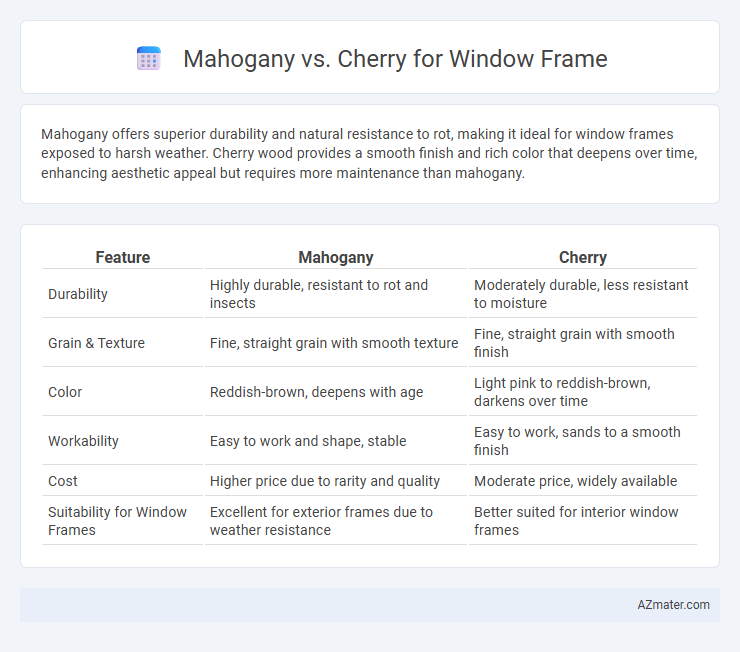Mahogany offers superior durability and natural resistance to rot, making it ideal for window frames exposed to harsh weather. Cherry wood provides a smooth finish and rich color that deepens over time, enhancing aesthetic appeal but requires more maintenance than mahogany.
Table of Comparison
| Feature | Mahogany | Cherry |
|---|---|---|
| Durability | Highly durable, resistant to rot and insects | Moderately durable, less resistant to moisture |
| Grain & Texture | Fine, straight grain with smooth texture | Fine, straight grain with smooth finish |
| Color | Reddish-brown, deepens with age | Light pink to reddish-brown, darkens over time |
| Workability | Easy to work and shape, stable | Easy to work, sands to a smooth finish |
| Cost | Higher price due to rarity and quality | Moderate price, widely available |
| Suitability for Window Frames | Excellent for exterior frames due to weather resistance | Better suited for interior window frames |
Introduction to Mahogany and Cherry Wood
Mahogany and cherry wood are popular choices for window frames due to their durability and aesthetic appeal. Mahogany is valued for its rich, dark reddish-brown color, fine grain, and resistance to decay and insects, making it ideal for long-lasting exterior applications. Cherry wood offers a warm, reddish hue that deepens with age and is known for its smooth texture and strength, providing both elegance and structural integrity for window frames.
Appearance and Grain Patterns
Mahogany window frames offer a rich, deep reddish-brown hue with a straight, fine grain pattern that provides a smooth and elegant finish. Cherry wood features a warm, reddish-orange tone that darkens over time, accompanied by a closed and fine grain pattern with subtle waves, giving windows a refined and sophisticated look. Both woods deliver visually appealing aesthetics, but mahogany's consistent grain contrasts with cherry's distinct aging process and natural luster.
Durability and Longevity
Mahogany and cherry wood both offer excellent durability for window frames, but mahogany is renowned for its superior resistance to decay, insects, and moisture, making it ideal for exterior applications exposed to harsh weather. Cherry wood, while durable, tends to be softer and more susceptible to dents and scratches, which may impact its longevity over time in high-traffic or exposed environments. The natural oils in mahogany enhance its dimensional stability and weatherproof qualities, ensuring longer lifespan compared to cherry in window frame construction.
Resistance to Weather and Termites
Mahogany window frames offer exceptional resistance to weather due to their dense, oily grain that repels moisture, preventing warping and decay over time. Cherry wood, while aesthetically rich and smooth, is less naturally resistant to termite infestations and requires regular treatment to maintain durability in humid or pest-prone environments. For long-lasting window frames exposed to harsh weather and termite risks, mahogany stands out as the superior choice.
Maintenance Requirements
Mahogany window frames require regular sealing and refinishing every 2-3 years to maintain their natural oils and prevent moisture damage, especially in humid climates. Cherry wood frames, while also benefiting from periodic refinishing, need less frequent maintenance due to their dense grain and natural resistance to decay and insects. Both woods demand routine cleaning and inspection to preserve structural integrity and aesthetic appeal, but mahogany's maintenance intensity is generally higher compared to cherry.
Workability and Installation
Mahogany offers superior workability for window frame installation due to its fine, even grain and natural resistance to warping, making it easier to cut, shape, and sand compared to cherry wood. Cherry requires more careful handling during installation because its tighter grain can make cutting and fastening slightly more challenging, yet it provides a smooth finish that enhances overall aesthetics. Both woods are durable, but mahogany's stability reduces installation errors and long-term maintenance needs, making it a preferred choice for high-quality window frames.
Cost Comparison
Mahogany window frames generally cost more due to their dense grain and durability, with prices ranging from $50 to $90 per linear foot. Cherry frames tend to be more affordable, priced between $30 and $70 per linear foot, offering a balance of beauty and cost-effectiveness. Both woods provide excellent strength, but budget-conscious projects often favor cherry for its lower initial investment.
Environmental Sustainability
Mahogany window frames offer excellent durability and natural resistance to decay, often sourced from sustainable plantations with certified forestry standards like FSC, reducing environmental impact. Cherry wood, while aesthetically pleasing with its rich, warm tones, is less commonly harvested sustainably, potentially contributing to deforestation concerns if not certified. Choosing FSC-certified mahogany over non-certified cherry frames supports responsible forest management and promotes long-term environmental sustainability in window frame construction.
Best Applications for Each Wood Type
Mahogany is ideal for window frames in humid or exterior environments due to its exceptional resistance to moisture, decay, and insect damage, making it perfect for coastal or tropical climates. Cherry wood, with its fine grain and rich reddish color, excels in interior window frames where aesthetic appeal and smooth finish are prioritized over weather resistance. Mahogany suits high-durability applications requiring stability and strength, while cherry is best for decorative, indoor settings emphasizing elegance and warmth.
Conclusion: Choosing the Right Wood for Your Window Frame
Mahogany offers exceptional durability and rich reddish-brown tones, making it ideal for window frames requiring long-lasting strength and a luxurious appearance. Cherry wood provides a smooth texture and warm, reddish hue that deepens over time, perfect for enhancing traditional or classic home interiors. Selecting between mahogany and cherry ultimately depends on your desired aesthetic, budget, and climate considerations, as mahogany excels in moisture resistance while cherry suits indoor environments with controlled humidity.

Infographic: Mahogany vs Cherry for Window Frame
 azmater.com
azmater.com